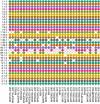Developmental and validation of a novel small and high-efficient panel of microhaplotypes for forensic genetics by the next generation sequencing
- PMID: 39402483
- PMCID: PMC11475632
- DOI: 10.1186/s12864-024-10880-4
Developmental and validation of a novel small and high-efficient panel of microhaplotypes for forensic genetics by the next generation sequencing
Abstract
Background: In the domain of forensic science, the application of kinship identification and mixture deconvolution techniques are of critical importance, providing robust scientific evidence for the resolution of complex cases. Microhaplotypes, as the emerging class of genetic markers, have been widely studied in forensics due to their high polymorphisms and excellent stability.
Results and discussion: In this research, a novel and high-efficient panel integrating 33 microhaplotype loci along with a sex-determining locus was developed by the next generation sequencing technology. In addition, we also assessed its forensic utility and delved into its capacity for kinship analysis and mixture deconvolution. The average effective number of alleles (Ae) of the 33 microhaplotype loci in the Guizhou Han population was 6.06, and the Ae values of 30 loci were greater than 5. The cumulative power of discrimination and cumulative power of exclusion values of the novel panel in the Guizhou Han population were 1-5.6 × 10- 43 and 1-1.6 × 10- 15, respectively. In the simulated kinship analysis, the panel could effectively distinguish between parent-child, full-sibling, half-sibling, grandfather-grandson, aunt-nephew and unrelated individuals, but uncertainty rates clearly increased when distinguishing between first cousins and unrelated individuals. For the mixtures, the novel panel had demonstrated excellent performance in estimating the number of contributors of mixtures with 1 to 5 contributors in combination with the machine learning methods.
Conclusions: In summary, we have developed a small and high-efficient panel for forensic genetics, which could provide novel insights into forensic complex kinships testing and mixture deconvolution.
Keywords: Complex kinships; Forensic genetics; Guizhou Han; Microhaplotype; Next generation sequencing.
© 2024. The Author(s).
Conflict of interest statement
The authors declare no competing interests.
Figures







Similar articles
-
Evaluation of a microhaplotypes panel for forensic genetics using massive parallel sequencing technology.Forensic Sci Int Genet. 2019 Jul;41:120-127. doi: 10.1016/j.fsigen.2019.04.009. Epub 2019 May 1. Forensic Sci Int Genet. 2019. PMID: 31071520
-
A 124-plex Microhaplotype Panel Based on Next-generation Sequencing Developed for Forensic Applications.Sci Rep. 2020 Feb 6;10(1):1945. doi: 10.1038/s41598-020-58980-x. Sci Rep. 2020. PMID: 32029845 Free PMC article.
-
Development and evaluation of a novel panel containing 188 microhaplotypes for 2nd-degree kinship testing in the Hebei Han population.Forensic Sci Int Genet. 2023 Jul;65:102855. doi: 10.1016/j.fsigen.2023.102855. Epub 2023 Mar 7. Forensic Sci Int Genet. 2023. PMID: 36947934
-
Microhaplotypes in forensic genetics.Forensic Sci Int Genet. 2019 Jan;38:54-69. doi: 10.1016/j.fsigen.2018.09.009. Epub 2018 Oct 1. Forensic Sci Int Genet. 2019. PMID: 30347322 Review.
-
Research progress on application of microhaplotype in forensic genetics.Zhejiang Da Xue Xue Bao Yi Xue Ban. 2021 Dec 25;50(6):777-782. doi: 10.3724/zdxbyxb-2021-0180. Zhejiang Da Xue Xue Bao Yi Xue Ban. 2021. PMID: 35347913 Free PMC article. Review. English.
Cited by
-
[Forensic performance and genetic background analyses of Guizhou Chuanqing population using a self-constructed microhaplotype panel].Nan Fang Yi Ke Da Xue Xue Bao. 2025 Jul 20;45(7):1442-1450. doi: 10.12122/j.issn.1673-4254.2025.07.10. Nan Fang Yi Ke Da Xue Xue Bao. 2025. PMID: 40673306 Free PMC article. Chinese.
References
-
- Tao RY, Dong XY, Chen AQ, Lü YH, Zhang SH, Li CT. Application progress of massively parallel sequencing technology in STR genetic marker detection. Fa Yi Xue Za Zhi. 2022;38(2):267–79. - PubMed
-
- Sun S, Liu Y, Li J, Yang Z, Wen D, Liang W, Yan Y, Yu H, Cai J, Zha L. Development and application of a nonbinary SNP-based microhaplotype panel for paternity testing involving close relatives. Forensic Sci Int Genet. 2020;46:102255. - PubMed
-
- Chandra D, Mishra VC, Raina A, Raina V. Mutation rate evaluation at 21 autosomal STR loci: paternity testing experience. Leg Med (Tokyo). 2022;58:102080. - PubMed
MeSH terms
LinkOut - more resources
Full Text Sources

